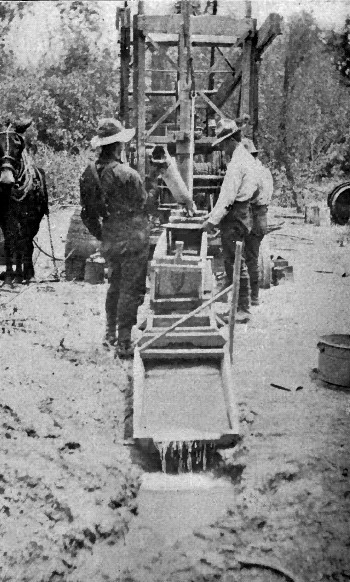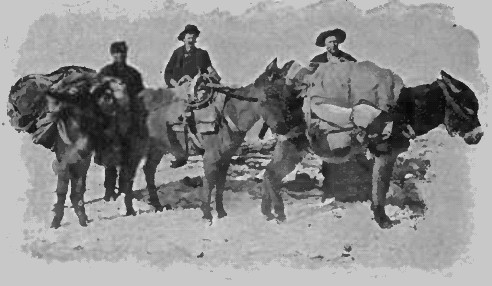Native gold is malleable, will flatten out under the hammer, and a steel knife will cut it with ease. It almost invariably contains silver, sometimes to the extent of one-fifth. A little practice will enable the prospector to recognize it, for there is but one king metal. Much gold is derived from copper and iron pyrite, and silver and lead ores are a very large source of supply. Gold is found in gravel of every variety, from finest pipe-clay to boulders weighing tons. Sometimes volcanic eruptions have covered these deposits since the ancient rivers laid them down, and in many cases their courses do not in the least agree with the valleys of the shrunken streams that have replaced them. Gold may be distributed through the whole thickness of a bed, but ninety-nine times out of a hundred the richest layer of gravel is just above the bed rock upon which all the gravel rests. Gold may even be found among the grass roots', especially in dry localities where there has been little water to carry it downward. When the bed rock consists of upturned slates the gold frequently penetrates it for some little distance. Sand is nearly always poorer than gravel.
The experience of miners in the Victoria gold fields is that gold is always found on the bars and points, and not in the deep pools and bends. The great difficulty with which any but the very finest particles of gold can be moved by water accounts for the value of the deposits depending largely upon the local rocks. It is very fortunate that gold's specific gravity is so great, for were it less its recovery would be much more difficult. The sluices and other apparatus of the miner are really nothing but the operations of nature imitated on a much smaller scale. There is one thing, however, time, that nature can afford to expend in prodigious periods, while man must not waste a single minute.
It not being possible to point out where the ancient river bed's sit, smothered as they are by hundreds of feet of overlying drift, lava, and other later deposits, the only feasible plan is a series of boring with the diamond drill. When gold has been discovered the finder must act with the greatest prudence, for even gold may be bought too dear. The surest test is a mill run, that is passing 10 to 50 tons through all the operations of crushing, milling, roasting, amalgamating, etc., and so ascertaining what returns are likely to be obtainable when the deposit is worked on a commercial scale. True sampling is necessary. All parts of the vein should be included, and the lode cross-cut by galleries in more than one spot. It is the very great necessity of these expensive preparatory explorations that has given rise to the saying, "Quartz mining is for rich men."
Many gold mines have been abandoned as unprofitable that could have been mined at a profit had their owners been wealthy and enterprising enough to do a great deal of expensive prospecting by diamond drill, cross cuts, drifts and rises. In one instance that came to the writer's knowledge a clever mining engineer cleared nearly $200,000 profit by leasing for a term of years a gold mine that was supposed to be exhausted. A drill hole sunk less than 50 feet below the old workings revealed a pocket of ore in the vein, and paying quartz was found for many hundred feet below.
With the improvements in electricity made recently a cheap power has been provided that will permit many mines to be reopened. The saving in working expenses effected by introducing electricity is often very large; after the plant is once installed the cost is almost nil where turbines can be employed to furnish the power to the generators. Machinery capable of delivering power at a distance of several miles from the plant, may be operated at very reasonable cost as compared to that of other prime movers. Discoveries of many deposits that have in time been successfully mined were the result of chance. No skill guided the finder; he merely stumbled upon his luck just as the wayfarer once in a while hits his toe against a well-filled pocketbook. For instance, a South Australian squatter picked up a piece of copper ore that a wombat had thrown out of his burrow, and the result was the discovery of the great Wallaroo lode. The first diamond from South Africa was picked up by an ignorant bush boy and kept with a lot of worthless pebbles in the private collection of the boy's master; no suspicion existed of its value until a passing trader had carried it away and obtained $2,500 for it in Capetown.
Gold was first discovered in California in 1848 by the superintendent of a sawmill who saw it glistening in the flume. Similarly gold was discovered in both Australia and Brazil by the purest chance. Had not a tree been uprooted by the wind the vast deposits of soft hematite iron ore in the Biwabic iron mines of the Mesabi range, Minnesota, might have remained unknown for many a long year to come. In the desolate region to the northward of Lake Huron great stores of nickel ore exist. These mines, which may some day regulate the price of the metal all the world over, were exposed in a railway cutting; no one dreamed of their existence. The Redington quicksilver mine in California was discovered by some road makers. Tradition relates that the enormously rich silver mines of Potosi, in Bolivia, were discovered by the accidental uprooting of a bush having spangles of silver ores attached to its roots. This was in 1538, and two hundred years later a similar streak of luck revealed the wealth of the Catorce district of Mexico, from which in thirty years, ore to the value of $35,000,000 was taken.
Moreover, the search for one mineral often leads to the discovery of another. The Comstock lode was first worked for gold, and the miners threw away the black sulfide of silver worth $3,000 to the ton. The Broken Hill mine in Australia was claimed as a tin deposit by its finder; it is now the greatest silver producer in Australasia. Such instances could be multiplied almost indefinitely, chance entering into a majority of mineral discoveries. On the other hand, it has happened, not infrequently, that purely scientific deductions and calculations have brought to light stores of mineral wealth. Certain minerals are likely to be found associated with each other. Cassiterite goes with boron and tourmaline, topaz, fluor spar and lithia-mica; all containing fluorine. It is also found with wolfram, chlorite and arsenical pyrites. Magnetite is often accompanied by rocks containing garnet, epidote and hornblende. Sphalerite and galena may occupy the same vein, which is likely to be of barite or heavy spar. Much galena carries silver. Gold is associated with many metallic sulfides such as iron, magnetic, and copper pyrites, mispickel, galena, blend, stibnite and tetrahedrite. Gypsum accompanies salt.
Continue on to:
Gossans and Other Surface Outcrops for Prospectors
Return To:
Gold and Silver Prospecting Basics


